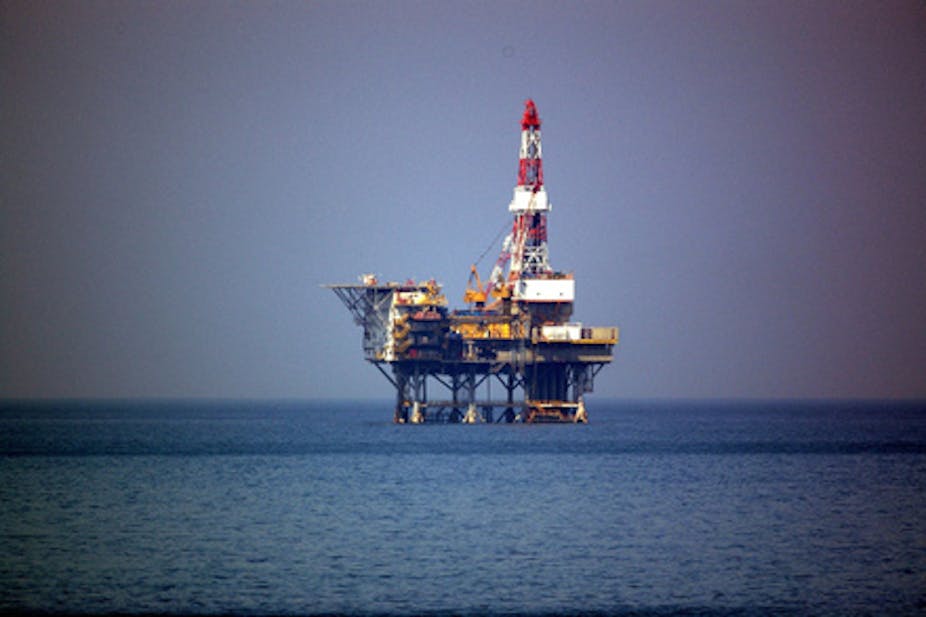The 2010 Deepwater Horizon explosion and spill reminds us of our ever-increasing footprint on our oceans. But could we be converting oil rigs from an environmental threat to a benefit?
We have long thought of the deep sea as safer from human disturbance than outer space. But few realize that the deep sea contains the world’s largest reserves of non-renewable resources, and that we will soon rely on these reserves as land sources dwindle.
That means more rigs. Already, thousands of petroleum rigs exist in offshore waters. The Gulf of Mexico alone contains more than 4000 rigs. This makes it the largest artificial reef complex in the world.
While rigs are often perceived as a threat to biological conservation, research from shallower waters indicates that these artificial reefs can actually enhance ecosystems.
As we approach a global peak in the number of rigs that are due for decommissioning, there is growing interest in a “rigs-to-reefs” program for the deep sea. In this program, obsolete offshore rigs are moved to deeper waters and recycled as artificial reefs, with coral settling on to these hard structures.
The financial savings of the rigs-to-reef program are clear (industry would save billions), but the ecological costs and benefits to deep sea ecosystem functioning has had little attention.
In a review article published in Frontiers in Ecology and the Environment, we asked, will the deep sea benefit from artificial habitat through a rigs-to-reef program? We put ethics aside and tackle this question from an ecological viewpoint.
The issue of whether to allow creation of artificial reef complexes usually centers around debate over whether they sustain increases in fish populations (the “production” hypothesis), or simply draw fish from surrounding habitat (the “attraction” hypothesis).
This seems to be a question that is rarely resolved because it requires monitoring regional fish populations over several decades, which is much longer than most policy makers and resource managers can afford to wait.
To get around this issue researchers are using proxies. Dr Milton Love and colleagues monitored rockfish around Californian oil rigs. They found that 20% of juvenile fish in the region were supported by eight rigs, and that those fish associated with rigs grew faster and survived longer.
Essentially, rigs were acting as fish nurseries. They predicted that the loss of a single rig would be equivalent to removing 29 hectares of natural habitat.
The potential benefits are more than just providing fish with habitat. Rigs could also act as de facto marine protected areas by acting as physical barriers to exclude illegal fish trawlers – a major problem in the deep sea.
Deep-sea organisms are highly vulnerable to exploitation because they are slow growing, produce few offspring and reproduce late relative to their shallower-water counterparts.
The orange roughy, for example, has been an easy target for commercial trawl fisheries and populations have already been decimated off the coast of Australia and New Zealand.
These fish take around 30 years to reach sexual maturity and travel hundreds of kilometers to form massive spawning aggregations around mountains rising from the seafloor (called “seamounts”). Rigs are like small seamounts - they’re the same basic shape and size - but they are unique because fish can live in the hollow space they provide, making them inaccessible to trawl nets.
By positioning rigs strategically within the deep sea, it would be possible to create “stepping stones” within otherwise inhospitable areas. This could make it easier for species to move from one area to another.
Scientists think that whale carcasses have served this purpose in the past. For example, they might have allowed mussels to work their way from shallower waters so they could colonise deep-sea hydrothermal vents.
If we know where species want to go, we could also position rigs so that they intercept larvae (for example, from cold-water corals) that might otherwise find nowhere to grow.
But it’s not all rosy; there are serious risks. Potential negative impacts include the release of contaminants as rigs corrode, physical damage to habitats and organisms within the “drop zone”, spread of invasive species, and undesired changes to food web dynamics.
Assessing these risks will require serious financial investment in deep sea research programs, and we suggest that industry savings from rigs-to-reef programs could fund environmental impact assessments by independent bodies, which could be overseen by representatives from government, community and industry to ensure transparency.

